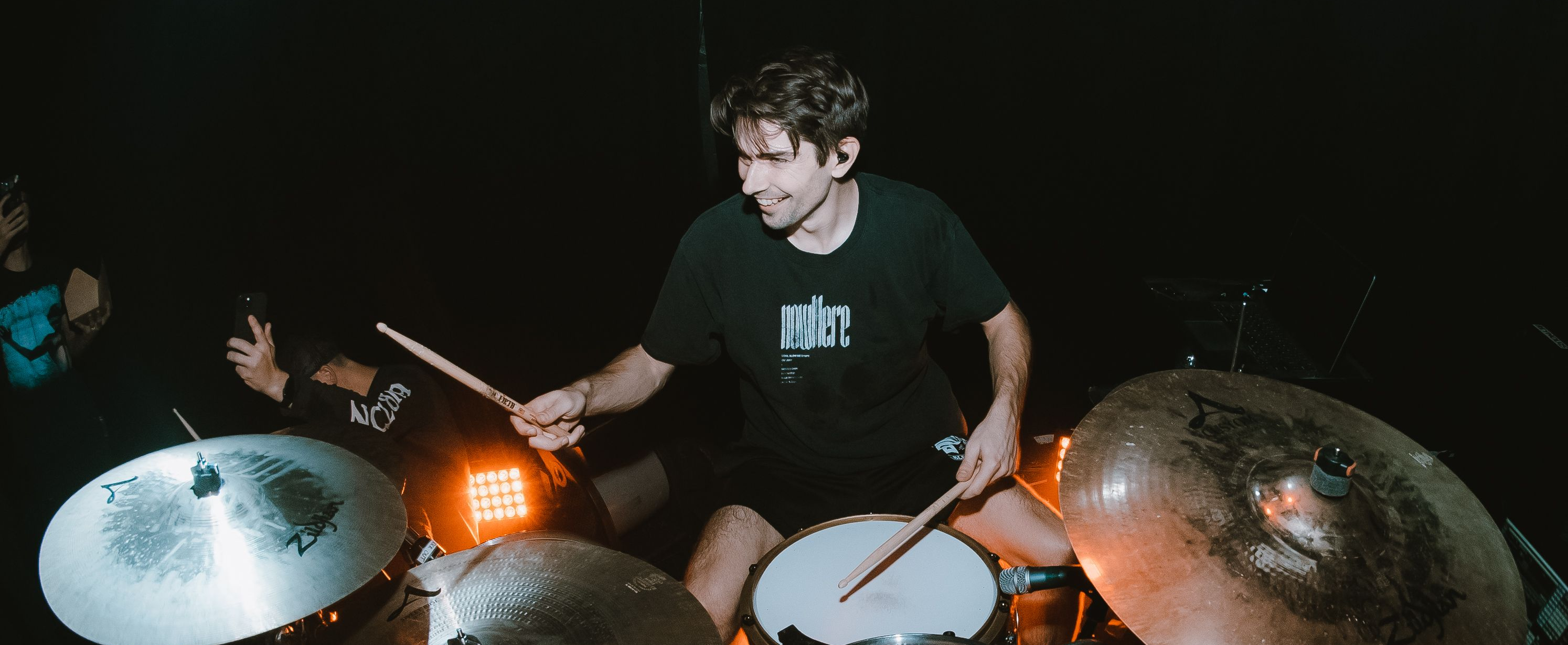If there’s a perfect representative for the term ‘jack of all trades,’ it’s Kyle Brownlee.
Brownlee is the drummer of the metalcore band Counterparts and founder of Soundblind Drums, his pandemic project turned legitimate business that captures all the depth and dimension of his devastatingly heavy drum kit. Oh, and he plays guitar too.
Since he started drumming as a child, Brownlee has found success as a recording artist, a songwriter, a plugin programmer, a sound designer, a YouTuber, and a Rock Band gamer. Somehow, he was able to find time in his busy schedule to talk to us about his past, his present, and what his future (hopefully) holds.
—
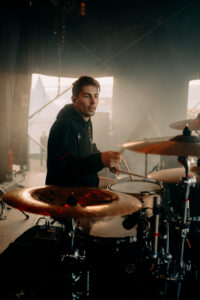
Kyle in action on the road.
Drew Van Buskirk: Let’s kick it off real easy. Tell us a little about yourself. Who is Kyle Brownlee?
Kyle Brownlee: Oh I don’t know–I’m just a guy who plays drums in a screaming band and also makes little plugins and sample packs here and there.
DVB: Take me back to the beginning: where did your musical journey start?
KB: I think the breakthrough was my cousin, who was a drummer and instrumentalist. I came over to his house one day, saw his drum kit, and thought, “OK, that’s kind of sick. I want to do that.”
DVB: Do you remember how many pieces the kit was?
KB: He had a decently sized kit. I think it had three rack toms, maybe two floors, a bunch of cymbals, but what really sold me was the double-kick pedal. That blew my mind.
DVB: Talk about formative memories. When did you join your first band?
KB: I started my first band with my friend Billy in the 9th or 10th grade. It was called Majesty, named after a Black Dahlia Murder live DVD. We played for a few years and actually weren’t terrible! I’m still proud of that.
DVB: Stealing the names of favorite albums or songs for your own band’s name felt like a rite of passage in high school, especially in the MySpace era.
How long after Majesty did Counterparts come into play?
KB: So, there’s a running joke among fans: ‘Who hasn’t been in Counterparts?’ I first filled in for them in 2012 when they were looking for a drummer after their original drummer left. At that point, I was transitioning from doing video game stuff on YouTube to real drum content. I put a cover of one of their tracks on YouTube, and Kenny, their merch manager, saw it. They hit me up, and I filled in for their headline tour.
DVB: When did you officially join the band?
KB: I fully joined in 2016. So, it’s been eight years now, which is insane to think about.
DVB: Time flies when you’re having fun! What Counterparts records can we hear you on?
KB: I started with “You’re Not You Anymore” in 2017. I’ve been on three full lengths: “You’re Not You Anymore,” “Nothing Left to Love,” and “A Eulogy for Those Still Here,” plus all the EP and B-side stuff from those sessions.
DVB: Even considering your previous experience with the group, what was the writing process like for you as a new member of a pretty well-established band?
KB: It’s a mix. When I filled in in 2012, I had to learn the songs note for note because they were so intricate. Now, we do drums last when recording, so I have time to sit with the demos and adjust stuff. I have more creative freedom now to do something crazy and put my own spin on it
DVB: Do you have any favorite records or tracks that you’ve worked on?
KB: Some of the sleeper hits on “Nothing Left to Love” and “A Eulogy for Those Still Here” are really cool. ‘Sworn to Silence’ is a favorite where I kind of ripped off one of my favorite bands. [Editor’s Note: We didn’t ask Kyle to snitch on himself here. Whoever he ripped off is none of our business.]
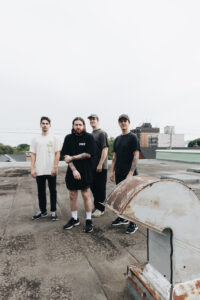
The current faces of Counterparts: Kyle, Brendan Murphy (vocals), Tyler Williams (bass), and Jesse Doreen (guitar)
DVB: You mentioned a moment ago that before your drum videos, you were making video game content. Could you elaborate on that?
KB: Yeah, I played the game Rock Band as a professional gamer. It was legitimately my job when I was in high school.
DVB: Wow, that’s incredible. How did that start and eventually transition into YouTube?
KB: It all began when Rock Band came out. I remember playing it at a friend’s house, probably after skipping school that day just to try it out. I thought, “I can play drums; this is going to be easy and fun.” But I actually sucked at it initially. So, I bought the game and every day after school, I would grind it out until I got to the point where I was number one on the leaderboard.
DVB: How did your experience with Rock Band videos translate to YouTube?
KB: Back then, YouTube was still in its early stages, especially for rhythm games. My videos would get pushed up in the algorithm and gain a lot of traction. I used a small, crappy digital video camera and taught myself some basic editing software to add overlays. I was just in my basement playing Rock Band, and I realized that if I could do this for a video game, I could probably do it for real drums too, showing people that I wasn’t just a guy hitting a plastic kit.
DVB: Was your audience receptive to that transition from Rock Band videos to real drum cam videos?
KB: There was definitely a drop-off because some people were there for the specific type of content. That said, I still have fans who have followed me from those early days. Sometimes, at shows, people come up to me and recognize me by my old Xbox Gamertag. It’s cool to see that long-time support.
DVB: What ultimately got you into production and eventually creating sample packs?
KB: After going to the studio for the first time with my high school band, I thought I could figure it out. I struggled in front of Reaper for a long time, learning from YouTube. Eventually, I started making drum tracks by chopping up sections of songs. During the pandemic, with no shows or touring, I went to the studio, filmed drum playthroughs, and decided to sample my kit. It started as something for me to use when writing Counterparts songs but evolved into Soundblind.
DVB: That’s a perfect segue: what is Soundblind?
KB: Soundblind is my project for creating drum sample packs. During the pandemic, I had a lot of time, so I went to the studio and sampled my kit. I didn’t have a mentor or guide, so I learned by doing, figuring out how sample packs work. It evolved from there, and now it’s something I’m really proud of.
DVB: What was your approach when you first started creating these sample packs?
KB: I kind of went in blind. (laughs) I knew what I wanted but had no idea how to achieve it. I spent a lot of time researching, watching YouTube tutorials, and trial and error. Eventually, I figured out how to get the sounds I wanted and started building my packs from there.
DVB: What’s the response been like so far?
KB: It’s been overwhelmingly positive. I think people appreciate the attention to detail and the effort I put into making them as high quality as possible. It’s been really rewarding to see other musicians using and enjoying something I created.
DVB: Have you collaborated with any other artists or producers on your sample packs yet?
KB: Not yet, but I’m definitely open to it. I think collaboration can bring new perspectives and ideas to the table, which is always a good thing. I’m excited to see where Soundblind goes in the future.
DVB: Since we’re getting into production-talk, I’d love to know how you use Slate Digital plugins in your day-to-day workflow.
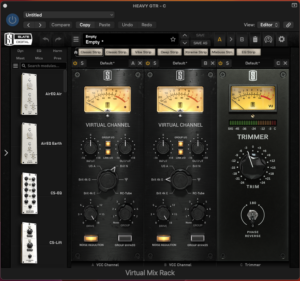
Kyle’s first step on every channel: Virtual Mix Rack and VCC Channel.
KB: Oh, absolutely. I use Slate Digital plugins extensively. My starting template for every track is built around Slate Digital’s Virtual Mix Rack (VMR) with the Virtual Console Collection (VCC).
A big part, if not all, of my drum sound for live drum cams and studio work comes through Slate Digital stuff. Every single track’s baseline processing is VMR with VCC. I’m printing saturation through VCC immediately; that’s the first step I do for every track.
I also stack two VCC instances on every channel, cranking the drive with the Brit 4K and Brit N consoles, just really hammering my tracks. And the Gates in VMR are untouchable—they’re the best gates you can use.
The Custom Series EQ and FG-Stress are huge go-tos for me, too. The Custom Series EQ is incredibly effective and often overlooked, but it adds so much with minimal effort. The Virtual Buss Compressor (VBC) rack is on every shell bus; sometimes I’m not even running it as a compressor, I’m just using its analog recreation. Slate Digital plugins are literally all over my tracks, from the kick drum to the master bus.
DVB: It sounds like you have a pretty firmly established and natural workflow, it’s very exciting to know that we’re such a big part of it.
KB: Definitely. Even before the subscription model, I would buy every new plugin because they consistently provide the best sound quality. The new SD-PE1 is great, too, especially the low end, which really stands out compared to others I’ve used.
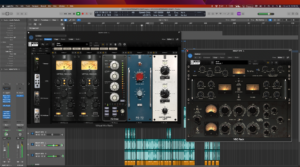
Some of Kyle’s go-to guitar processing plugins.
DVB: Ok, I’ve kept you long enough—I think we should wrap up this lovely conversation with some words of wisdom. What advice would you give to aspiring drummers or musicians?
KB: Just keep at it. It’s a long and often difficult journey, but if you’re passionate about it and willing to put in the work, it’s incredibly rewarding. Don’t be afraid to make mistakes and learn from them. And most importantly, have fun with it. Music is supposed to be enjoyable, so don’t lose sight of that.
DVB: Any other parting words you’d like to share?
KB: Just a big thank you to everyone who’s supported me and Counterparts over the years. It’s been an amazing journey, and I can’t wait to see what the future holds. And if you haven’t checked out Soundblind yet, give it a look. I think you’ll like what you hear.
DVB: Thanks so much for your time, Kyle. It’s been great chatting with you.
KB: Thanks, man. I appreciate it.
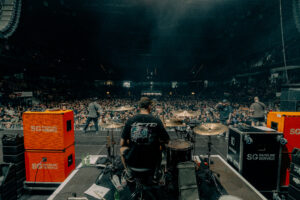
Counterparts on tour.
—
